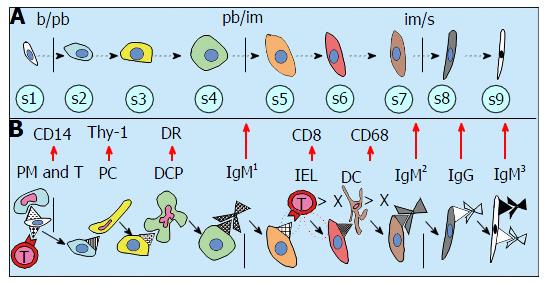Copyright
©The Author(s) 2016.
World J Stem Cells. Dec 26, 2016; 8(12): 399-427
Published online Dec 26, 2016. doi: 10.4252/wjsc.v8.i12.399
Published online Dec 26, 2016. doi: 10.4252/wjsc.v8.i12.399
Figure 4 Hierarchy of tissue cell differentiation by an involvement of distinct elements of the tissue control system.
A: The differentiation of tissue cells may pass up to nine stages (s1-s9). The epithelial cells pass through basal to parabasal b/pb, from parabasal to intermediate pb/im and from intermediate to superficial im/s layers, with intermediate steps in between; B: Cellular differentiation is regulated by distinct IMS components. The stem cell asymmetric division is mediated by primitive MDC (PM) and T cell (T). The pericytes (PC) cause s2 > s3 transition by substances released from Thy-1 intercellular vesicles. DR+ dendritic cell precursors (DCP) stimulate s3 to s4 transfer, s4 > s5 stage is caused by a binding of IgM1, and regression of intraepithelial T lymphocytes (IEL) induces s5 > s6 transition. Regressing dendritic cells (DC) cause s6 > s7 change, binding of IgM2 induces s7 > s8 transfer, and binding of IgG accompanies s8 > s9 stage exhibiting a binding of IgM3. > X indicates the regression IEL and DC[1].
- Citation: Bukovsky A. Involvement of blood mononuclear cells in the infertility, age-associated diseases and cancer treatment. World J Stem Cells 2016; 8(12): 399-427
- URL: https://www.wjgnet.com/1948-0210/full/v8/i12/399.htm
- DOI: https://dx.doi.org/10.4252/wjsc.v8.i12.399









